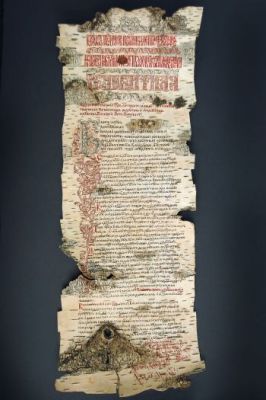Recently our museum received a chelobitnaya
We have almost completed one the most unusual collections of our museum – applications to become a member of the National Union of Calligraphers. Every applicant had to write a manifest in her own calligraphy style, so that every master could demonstrate her skills and sense of taste. That is why every applicant tries her best to make the most beautiful and unusual application.
Maybe the most exceptional application was made by Yuri Koverdyayev. He has written a classical chelobitnaya in Old Church Slavonic. It is made on birch bark imitating the original samples of the XVI century. Yuri Koverdyayev managed not only to reproduce the true script and graphic elements of those days but also to convey typical stylistics of the period.

Calligraphy on birch bark is one of the styles Mr. Koverdyayev uses in his art. Treating birch bark is a labour-intensive process. To get a good piece of birch bark you should find an old dry birch tree and unbark it with the hatchet. Then operating with a pincer and a magnifier you have to delete the surface layers. When you reach the so-called “rose” layer, the birch bark has to be drenched and put under press.
Our birch bark chelobitnaya is quite a big art piece: 30x70 cm. Ragged edges and many knots contrasting the delicately executed drop cap and pattern add refinement to the artwork.
This art piece will be available at the II International Exhibition of Calligraphy together with many other artistic applications.
A chelobitnaya (application) is distinguished by a fixed form that remained unchanged till this day. Usually it started with an appeal to the Tsar (it was called “hit the floor with your forehead”, in Russian “chelom bit” meaning “make obeisance”). Further the applicant told about himself (historians believe the volume of autobiographical information depended on the social status of an applicant). The document had to be finished with the obligatory phrase “put my hand to it”, meaning “signed by” and a personal signature.